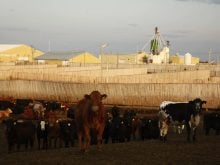This cattle market information is selected from the weekly report from Canfax, a division of the Canadian Cattlemen’s Association. More market information, analysis and statistics are available by becoming a Canfax subscriber by calling 403-275-5110 or at www.canfax.ca.
Basis remains weak
Last week had steady prices for the western Canadian market, but prices lost ground to the U.S. market. Alberta fed prices are now estimated at around a $10.50 per hundredweight discount against the Nebraska market. This is the weakest basis level in a year.
Read Also

U.S. softens fees on Chinese shipping
The U.S. starts charging new fees on Chinese ships on Oct. 14. What are the ramifications for their ag exports?
Feedlots are selling fed cattle at a negative margin now but are bringing in new calves and feeders that are near break-even levels. Based on the latest Canfax Trends report, steer and heifer calves placed in March 2021 and marketed over the past month on average were negative $341 per head, and backgrounded feeders (850 pounds) placed in June 2021 are losing on average $218 per head.
Competition on the cash market was limited. Buyers are keeping a close tab on weights and want to procure the biggest cattle to help keep weight under control.
Light trade last week saw dressed sales ranging from $261-$263 per cwt. delivered. Cattle were being scheduled for the week of Dec. 13 delivery.
In Ontario, dressed sales were reported at $270 per cwt. delivered, fully steady with the previous week. Prices have been flat for the past 10 weeks. Steer and heifer carcass weights are 18 and 25 lb. lighter, respectively, compared to last year.
In the U.S., early sales last week were steady at US$132 per cwt. live and $207 per cwt. dressed. Dressed sales in Iowa and Nebraska were reported from $208-$211 per cwt., $4 per cwt. higher than the previous week.
Live sales in Texas and Kansas ranged from $133-$134 per cwt., $1-$2 per cwt. stronger. Fed cattle prices are at the highest point since June 2017.
According to the U.S. Department of Agriculture, the all-fresh beef retail price for October was reported at $7.55 per lb., a new record high. Beef retail prices are 21 percent higher than last year.
Cow prices rise
Non-fed prices rebounded higher last week on seasonally tightened supplies. Slaughter cow prices realigned from historic lows seen the previous week and were around $4 per cwt. higher at auction. D2 and D3 cows averaged $64.67 and $56.07 per cwt. respectively.
Dressed cow bids firmed $1 per cwt., ranging from $123-$128 per cwt. delivered. Butcher bull prices rallied $3 per cwt. higher, averaging $95.95 per cwt. Slaughter cow prices appear to have found a fourth quarter bottom and are expected to strengthen.
A light offering of bred cows last week averaged $1,262.50, and bred heifers traded from $1,400-$2,175 per head.
Feeder demand soft
Volatile feedgrain prices and supplies and limited feedlot bunk availability softened feeder demand last week, and prices eased $2-$3 per cwt. lower on a moderate offering. Light calves from 400-600 lb. traded unevenly softer with steers generally $4.50 per cwt. lower than the previous week. Similar weight heifers saw a more modest $1.50-$3.25 per cwt. price decline.
Mid-weight 500-600 lb. steer calves eased lower for a third week and are now trading at the lowest level seen since the first quarter of 2017. Larger calves from 600-800 lb. also saw significant declines, down $3.50-$4.25 per cwt. from the previous week.
Ontario calves continue to trade at a premium to Alberta and good eastern buying interest was seen last week. Alberta steer calf prices are at a discount relative to Manitoba. Large feeders heavier than 800 lb. saw good demand on a limited offering, and prices were generally steady to $2 per cwt. lower than the previous week.
Auction volumes continue to seasonally tighten as the fall run moderates after an early start. Weekly auction volumes were 40 percent smaller than the previous week at 47,680 head and were 15 percent lower than a year ago. Year-to-date auction volumes were 25 percent larger, totalling 1,527,878 head.
Feeder exports to the United States for the week ending Nov. 6 surged 36 percent larger than the previous week to 4,879 head and were 54 percent larger than the same week last year.
Cutouts lower
In U.S. beef trade, cut-out values slid lower and encouraged the largest weekly box movement so far this year. Choice averaged US$276.16 and Select averaged $263.16 per cwt. Last week’s total cattle slaughter was estimated at 677,000 head, three percent larger than the previous week.
















